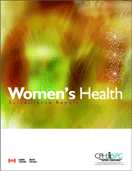
|
|


[Previous] [Table of Contents] [Next]
Perimenopausal and Postmenopausal Health
Angela M. Cheung, MD, PhD, FRCPC; Ruhee Chaudhry, MSc; Moira Kapral, MD, MSC,
FRCPC; Cynthia Jackevicius, Dpharm (University Health Network); and Gail Robinson,
MD, FRCPC (University of Toronto)
Health Issue
The perimenopausal phase of a woman's life can span several years. The changes that
occur during this period of transition will affect women to varying degrees. For some
women, symptoms can be severe and disruptive, and for others the transition is welcomed.
Clinical and epidemiologic data on women in perimenopause are limited and come
primarily from Caucasian populations. Somewhat greater attention has been given
to postmenopausal women's health, and these data are often extrapolated to women
in perimenopause. The average age of natural menopause in Western societies is estimated
to be 51 years, so that women in Canada can expect to live, on average, a third of
their lives in postmenopausal years. During these years women are at increased risk
of chronic diseases such as osteoporosis and cardiovascular disease.
Morbidity data from the Canadian Institute for Health Information (CIHI), Statistics
Canada's Canadian Mortality Database, and the FASTRAK II database (of acute cardiac
hospital admissions across Canada) were analyzed to explore these conditions further.
Key Findings
- Clinical and epidemiologic data on women in perimenopause are limited. There are no adequate Canadian data on symptom severity and prevalence among perimenopausal and postmenopausal women. Existing data on age at menopause and experience of the menopausal transition come primarily from Caucasian populations.
- Perimenopausal and postmenopausal women differ hormonally and experientially. Therapies tested on one population should not necessarily be extrapolated to the other.
- Psychiatric disorders are not significantly increased among menopausal women, although there may be some increase in psychiatric symptoms in perimenopause.
- Scientific evidence is lacking to support or refute claims that commonly used botanical products can offer therapeutic relief of menopausal symptoms. There are inadequate data on the efficacy, side effects, and pharmacokinetics of these products. However, recent studies have demonstrated their estrogenic activity, suggesting a potential for their use and a viable mechanism of action.
- Consistent with previous studies, recent data from the Women's Health Initiative suggest that combination hormone therapy increases the risk of stroke, coronary artery disease, and breast cancer. The study did demonstrate a decrease in risk of colon cancer and hip fracture. Hormone therapy is no longer recommended for the prevention of chronic diseases for asymptomatic women.
- Stroke is an important issue for perimenopausal and postmenopausal women. Sex differences may exist in the secondary prevention of stroke. Women may be less likely than men to receive antiplatelet agents and carotid endarterectomy for secondary stroke prevention, although further research is needed on whether this is due to sex alone or to age or other clinical factors.
- Osteoperosis affects an estimated one in six women and one in sixteen men over the age of 50. Women are greater risk of osteoporosis and osteoporotic fractures than men. However, women have lower in-hospital mortality rates than men following hip fracture.
Data Gaps and Recommendations
The authors identified the following data gaps and made the following recommendations:
- Conduct clinical and epidemiologic research aimed at better understanding the menopausal transition and defining its clinical phases. In order to collect data on perimenopausal women, we must be able to identify them. Age is often used as a surrogate for menopausal status, making it difficult to differentiate conditions that may be due to biological changes from those that may be attributed to other factors.
- Investigate alternative combinations and doses of hormone therapy, in light of known risks and benefits, with respect to treatment of menopausal symptoms and long-term outcomes.
- Investigate non-pharmacological alternatives (risks and benefits) for the treatment of menopausal symptoms, particularly those already in common use.
- Educate health care practitioners and women on the risks and effective treatment related to cardiovascular disease so that they may present for treatment more quickly and receive the most effective therapies.
- Investigate the use of ovarian hormones to augment the effect of antidepressants in menopausal women.
[Previous] [Table
of Contents] [Next]
|




